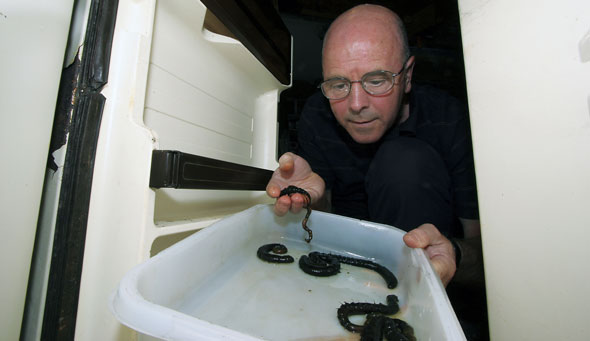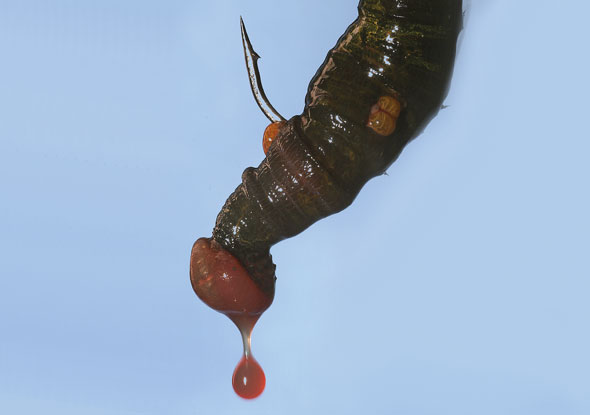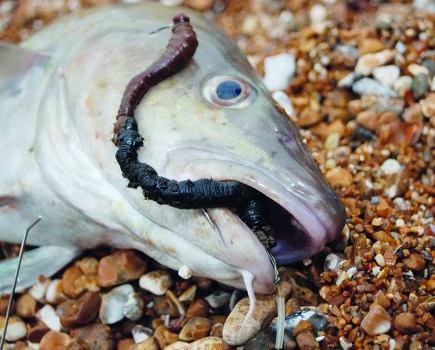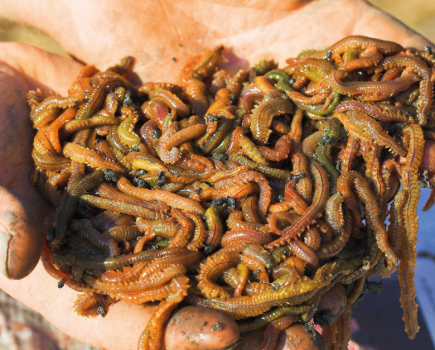Why are blow lug much easier to dig? Because they are more common for a start and inhabit a wider area of any beach.
They also live closer to the surface and can be found in quite dense colonies so trench digging them with a flat-tined potato fork can be very particularly productive.
As with black lug I keep them in shallow trays and if there is not enough room in the fridge they are usually quite happy just placed on the floor in the garage and covered with something suitable to keep them in the dark.
I believe that keeping worms in the dark makes them last longer, probably because there isn’t any light at the bottom of a lugworm burrow.
Blow lug will generally last longer than blacks and rather than keep them for more than a few weeks, after which they become washed out and look like bloated sausages with flimsy tails, I freeze them.
This is done by drying them out on newspaper, putting about 20 into a sandwich bag with salt in the bottom, and then shaking them until they are covered in salt. After sealing the sandwich bag I place it on a metal tray in the freezer to speed up the freezing process and, once frozen, place the bag into a plastic container with holes in the lid.
They are not the best bait to freeze because the salt creates some liquid in the bottom of the bag, which is why I keep them in a plastic container in case the bag leaks.
They don’t remain in good condition for long and if I haven’t used them within a few weeks I throw them out regarding them as a top up bait.
When preparing blow lug for a session I place several handfuls of worms onto sheets of newspaper laid in the bottom of a bucket where they will stay healthy.
Black lug need more care because often you pick them up and they burst. I place just two or three onto individual sheets of a paper hand towel and layer these into a small container that fits inside my bucket.
I try to work out how many worms I expect to use and never take any more than this because I try not to disturb them in their trays. I have put plenty of effort into getting them so I am not going to waste them by causing them to burst and having to freeze them.
They are still a very effective frozen bait so I haven’t really wasted them as such, but I still like to use fresh bait when possible. However, I definitely do not like wasting them on whiting, which exist in almost plague proportions along my local shoreline in winter.
So if conditions only look suitable for whiting with perhaps an opportunity for cod I will only take half a dozen black lug with me and use these usually over high water, or whenever I think the chances of hooking a cod are best.
LUGWORMS: THE CLASSIC COD BAIT
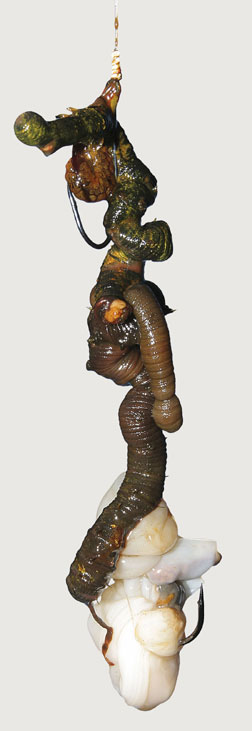 There are times when a foraging winter cod will look at nothing else but a bunch of lugworms. At other times they will account for most species and are particularly effective for whiting and various flatfish.
There are times when a foraging winter cod will look at nothing else but a bunch of lugworms. At other times they will account for most species and are particularly effective for whiting and various flatfish.
The classic North East bait of one or two big runnidowns tipped off with a white ragworm or clam is hard to beat and has accounted for many cod over the years.
Black lug are seen as a far superior cod bait and even a single big worm will take cod.
I have tried this on a my local beaches to see if it works and, although a hooked single worm looks small, it has still accounted for plenty of cod over the years.
This is not the big-mouthed cod bait that most anglers are familiar with but it does work.
Most anglers are more confident using a big bait when fishing for large mouthed species, such as cod or bass, and if the big black worms are not available then several blow lug will be needed to form the foundation of a hook bait.
Lugworms are often best used as the basis of a cocktail tipped with a tougher bait, like squid or a piece of crab.
This should prevent the worms from sliding down the hook shank into a messy blob, although this usually only happens with blow lug as the black ones are a lot tougher.
If you are fishing for whiting use a small sliver of mackerel or squid and, if necessary, tie the bait onto the hook. If chasing cod go for a bigger section of squid, clam or peeler crab, again tied with elastic thread.
When it comes to hook choice, I go for the classic Aberdeen made from thicker wire, even in small sizes for whiting or flatties, just in case something unexpectedly bigger comes along.
With the exception of fishing over the heaviest rocks or thick kelp beds I always use a Pennell rig armed with a size 4/0 Aberdeen and a 4/0 Viking, which should be strong enough for average size fish.
Even when using smaller hooks for whiting or flatties I will still use a tandem Pennell rig comprising 1/0 to 2/0 Limerick hooks. It may look a light outfit but it will hold a decent surprise cod.
Hooking several smaller lugworms together to form a bigger bait works and I don’t think it matters what end of the body you hook them through first, as long as the finished product becomes one big juicy bait.
If using just one or two or a big black lugworm I always hook it or them through the tail first as this means that the juicy body part is at the hook point, assuming that the fish will prefer the body part rather than a tail end, and find my hook!
Lugworms could help cancer patients recover
Scientists have long recognised the need for an efficient, non-toxic, oxygen carrying protein molecule, which could have medical benefits.
Professor Peter Olive and his research team at Newcastle University have identified how oxygen-rich blood extracted from lugworms could help the recovery of cancer patients, stroke sufferers and accident victims. The research team is now among the world leaders in producing the worms and last year they bred 200 million of them for fish food and commercial use, such as the now famous Seabait company.
Their technical knowledge will be made available to French firm, Hemarina, who will develop the use of the worm’s oxygen-rich haemoglobin.

A group of five worms is about the right width to store in a wide-mouthed flask for fishing and you can get four parcels in a flask.
